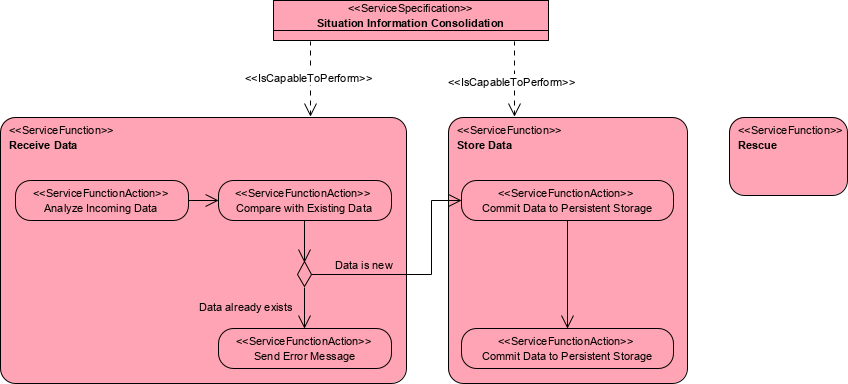The SOV-5 defines the behaviour of a service in terms of the functions it is expected to perform.
SOV-5 is the key behavioural specification for services. Equivalent in nature to OV-5, Operational Activity Model, and SV-4, Functionality Description, it specifies a set of functions that a service implementation is expected to perform.
Usage
The intended usage of the SOV-5 includes:
- Service specification.
- Functional requirements definition.
Product Description
An SOV-5 specifies the required functionality that an implementation of a service is expected to have; (the implementation of that behaviour is represented in SV-4, Functionality Description and SV-5, Function to Operational Activity / Service Function Traceability Matrix). An SOV-5 is usually presented as a functional diagram, with optional flows. An SOV-5 product should also show which service the functions correspond to.
Note that an SOV-5 should be a statement of what a service implementation is to do rather than how it is to do it. The functions specified in an SOV-5 should be essential to the service rather than an attempt to steer a particular implementation approach.
Creating a Service Functionality (diagram)
To create a Service Functionality diagram:
- Click on Service Functionality in the Action Artifact area, and then select Create New Diagram.
- Type the diagram name and press Enter.
- A blank diagram is created and you can start constructing the view. Create ServiceFunction through the tool under the diagram toolbar.
- Reuse ServiceSpecification (recommended) through dragging and dropping them from the Model Explorer. ServiceSpecification are defined in S1.
- Connect ServiceSpecification and ServiceFunction with IsCapableToPerform if necessary.
- You can optionally specify the composition of ServiceFunctions by creating ServiceFunctionActions in them.

MODAF in Visual Paradigm
The MODAF is brought to you by Visual Paradigm, a full-featured development platform. Visual Paradigm provides an easy-to-use, model-driven MODAF tool that supports the development of MODAF views and models. You can create integrated MODAF products and generate architectural documents that facilitate organizations to efficiently coordinate enterprise architecture initiatives.